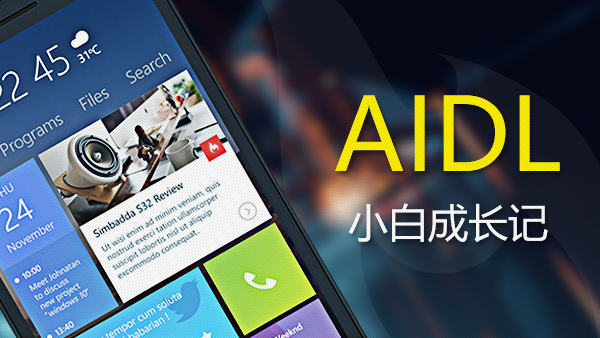Android异步消息机制架构
Android异步消息处理架构,其实没那么复杂。简单来说就是 looper 对象拥有 message queue ,并且负责从 message queue 中取出消息给 handler 来处理。同时 handler 又负责发送 message 给 looper ,由 looper 把 message 添加到 message queue 尾部。就一个圈儿。下面给出图解,应该不难吧?

所以很明显 handler 和 looper 是来联系在一起的。需要说明的是,多个 message 可以指向同一个 handler ,多个 handler 也可以指向同一个 looper 。
还有一点很重要,普通的线程是没有 looper 的,如果需要 looper 对象,那么必须要先调用 Looper.prepare() 方法,而且一个线程只能有一个 looper 。调用完以后,此线程就成为了所谓的 LooperThread ,若在当前 LooperThread 中创建 Handler 对象,那么此 Handler 会自动关联到当前线程的 looper 对象,也就是拥有 looper 的引用。
Looper
简而言之, Looper 就是一个管理 message queue 的类。我们直接来看下源码好了。
public class Looper {
...... private static final ThreadLocal sThreadLocal = new ThreadLocal(); final MessageQueue mQueue;//拥有的消息队列
...... /** Initialize the current thread as a looper.
* This gives you a chance to create handlers that then reference
* this looper, before actually starting the loop. Be sure to call
* {@link #loop()} after calling this method, and end it by calling
* {@link #quit()}.
*/
//创建新的looper对象,并设置到当前线程中
public static final void prepare() { if (sThreadLocal.get() != null) { throw new RuntimeException("Only one Looper may be created per thread");
}
sThreadLocal.set(new Looper());
}
····· /**
* Return the Looper object associated with the current thread. Returns
* null if the calling thread is not associated with a Looper.
*/
//获取当前线程的looper对象
public static final Looper myLooper() { return (Looper)sThreadLocal.get();
} private Looper() {
mQueue = new MessageQueue();
mRun = true;
mThread = Thread.currentThread();
}
......
}由源码可知, looper 拥有 MessageQueue 的引用,并且需要调用 Looper.prepare() 方法来为当前线程创建 looper 对象。Android注释很详细的说明了这个方法。
This gives you a chance to create handlers that then reference
this looper, before actually starting the loop. Be sure to call
loop() after calling this method, and end it by calling
quit()
也就是说只用在调用完 Looper.prepare() 之后,在当前的线程创建的 Handler 才能用有当前线程的 looper 。然后调用 loop() 来开启循环,处理 message .来简单看一下 loop() 的源码
public static void loop() { final Looper me = myLooper();//获取looper对象
if (me == null) { //若为空则说明当前线程不是LooperThread,抛出异常
throw new RuntimeException("No Looper; Looper.prepare() wasn't called on this thread.");
} final MessageQueue queue = me.mQueue; 获取消息队列
..... for (;;) { //死循环不断取出消息
Message msg = queue.next(); // might block
if (msg == null) { // No message indicates that the message queue is quitting.
return;
} // This must be in a local variable, in case a UI event sets the logger
//打印log,说明开始处理message。msg.target就是Handler对象
Printer logging = me.mLogging; if (logging != null) {
logging.println(">>>>> Dispatching to " + msg.target + " " +
msg.callback + ": " + msg.what);
} //重点!!!开始处理message,msg.target就是Handler对象
msg.target.dispatchMessage(msg); //打印log,处理message结束
if (logging != null) {
logging.println("<<<<< Finished to " + msg.target + " " + msg.callback);
}
.....
}
}很明显,就是一个大的循环,不断从消息队列出取出消息。然后调用一个很关键的方法 msg.target.dispatchMessage(msg) 开始处理消息。 msg.target 就是 message 对应的 handler .其实我一直在重复文章开头的概念。 looper 对象管理 MessageQueue ,从中取出 message 分配给对应的 handler 来处理。
在分析 msg.target.dispatchMessage(msg) 方法之前,先让大家了解下 message 和 handler
Message
Message 就是一些需要处理的事件,比如访问网络、下载图片、更新ui界面什么的。 Message 拥有几个比较重要的属性。
public int what 标识符,用来识别 message
public int arg1,arg2 可以用来传递一些轻量型数据如int之类的
public Object obj Message 自带的Object类字段,用来传递对象
Handler target 指代此 message 对象对应的 Handler
如果携带比价复杂性的数据,建议用 Bundle 封装,具体方法这里不讲了。
值得注意的地方是,虽然 Message 的构造方法是公有的,但是不建议使用。最好的方法是使用 Message.obtain() 或者 Handler.obtainMessage() 能更好的利用循环池中的对象。一般不用手动设置 target ,调用 Handler.obtainMessage() 方法会自动的设置 Message 的 target 为当前的 Handler 。
得到 Message 之后可以调用 sendToTarget() ,发送消息给 Handler , Handler 再把消息放到 message queue 的尾部
Handler
public Handler(Looper looper, Callback callback, boolean async) {
mLooper = looper;
mQueue = looper.mQueue;
mCallback = callback; //handleMessage的借口
mAsynchronous = async;
}上面是 Handler 构造器,由此可知,它拥有 looper 对象,以及 looper 的 message queue 。
要通过 Handler 来处理事件,可以重写 handleMessage(Message msg) ,也可以直接通过 post(Runnable r) 来处理。这两个方法都会在looper循环中被调用。
还记得刚在loop循环中处理信息的 msg.target.dispatchMessage(msg) 方法。现在我们来看下这个方法的源码。
public void dispatchMessage(Message msg) { //注意!这里先判断message的callback是否为空,否则就直接处理message的回调函数
if (msg.callback != null) {
handleCallback(msg);
} else { if (mCallback != null) { //正是在这调用我们平常重写handleMessage
if (mCallback.handleMessage(msg)) { return;
}
}
handleMessage(msg);
}
}没错,正是在这个方法中调用了 handleMessage(Message msg) 。值得注意的是,再调用 handleMessage(Message msg) 之前,还判断了message的callback是否为空。这是为什么?
很简单,这就是 post(Runnable r) 方法也能用来处理事件的原因。直接看它的源码。我就不赘述了。相信已经很清晰了。
public final boolean post(Runnable r){ //获取消息并发送给消息队列
return sendMessageDelayed(getPostMessage(r), 0);
}private static Message getPostMessage(Runnable r) { //创建消息,且直接设置callback
Message m = Message.obtain();
m.callback = r; return m;
}总结
现在一切都弄清楚了。先调用 Looper.prepare() 使当前线程成为 LooperThread , Looper.loop() 开启循环之后,然后创建 message ,再由 Handler 发送给消息队列,最后再交由 Handler 处理。下面是官方给出的LooperThread最标准的用法。
class LooperThread extends Thread { public Handler mHandler; public void run() {
Looper.prepare();
mHandler = new Handler() { public void handleMessage(Message msg) { // process incoming messages here
}
};
Looper.loop();
}最后的最后,再提一下,平时在说的主线程也就是UIThread,也是一个LooperThread。这也是为什么我们能在子线程中发送消息,然后在主线程中更新ui。因为 Handler 是在主线程创建的,所以 Handler 关联的是主线程的 looper ,最后给一个更新ui的实例。
private static Handler handler=new Handler();@Overrideprotected void onCreate(Bundle savedInstanceState) { super.onCreate(savedInstanceState);
setContentView(R.layout.message_activity);
new Thread(new Runnable() {
@Override
public void run() { // tvTest.setText("hello word");
// 以上操作会报错,无法再子线程中访问UI组件,UI组件的属性必须在UI线程中访问
// 使用post方式设置message的回调
handler.post(new Runnable() {
@Override
public void run() {
tvTest.setText("hello world");
}
});
}
}).start();
}原文链接:http://www.codeceo.com/article/android-handler-looper-message.html

 随时随地看视频
随时随地看视频




